Matador Network's Blog, page 610
August 13, 2021
How a midlife gap year could stave off that future midlife crisis

Americans are burning out, in no small part because workers fail to take advantage of their allotted paid time off for fear of falling behind. We’re going to sleep at 23 years old, waking up at 40, looking at our not-quite-empty but not-quite-robust bank accounts and saying with a shrug, “well, it could be worse.”
Yeah, it could. But it could also be much, much better.
As times change, trends evolve. If a classic midlife crisis is calling to you, by all means stomp off into the woods for a week, do your best Thoreau impression, commune with nature, contemplate the meaning of life, and then return dirtier and more pissed off than ever. Or you could take a midlife gap year instead.
The midlife gap year is, or at least should be, the next iteration of the midlife crisis. It’s pretty simple: Just take the concept of a traditional gap year — a year off in between high school and college to travel — and apply it to the adult world. With remote work, it’s becoming more and more feasible to pick up and hit the road while still receiving a paycheck. Depending on your financial situation and relationship status, you could even leave the job behind, too.
Take a year off. Rent a van. Hitchhike. Live in another part of the country, or the world. Whatever you do, don’t do it with a crisis mindset — have a sense of purpose and a commitment to self-discovery, and return with a fresh perspective on your personal and professional future.
Take the trip you’ve been putting offThe standard US allowance of two PTO weeks per year is one issue that seems to unite everybody: it’s not nearly enough time. Between family obligations and mental health breaks, we’re lucky if we can fit one five-day vacation into our schedule each year. The result? Frustrated American workers sitting at their desks scrolling longingly through Skyscanner and Expedia, fantasizing about the trips they wish they could take. While this might be a fun diversion, it certainly isn’t a healthy long-term habit.
Much like a traditional gap year, a midlife gap year is, on its most superficial level, a time for you to venture out of your bubble. When your routine is largely the same every day, life can feel pretty claustrophobic. A midlife gap year gives you some much-needed distance and breathing room. Take the trip you’ve always been planning in your head. Go live on the opposite coast, or abroad. Have the experiences you’ve been daydreaming about while you sit at your desk, bored and waiting for the clock to strike five. You might return to the exact same routine once the year is over, but you’ll do so with a handful of new experiences under your belt.
Avoid burnoutFinding happiness as an adult is as much about fulfilment as it is about avoiding burnout. The workday used to end at five. Now, thanks to technology, it simply continues at home (if we ever left home in the first place) on our laptops and iPhones with the oft-uttered expression, “hold on, I just have to answer this email real quick.” In a world where everyone is constantly plugged in, it can be hugely beneficial to disconnect from it all.

Photo: Photomario/Shutterstock
Even if you continue working from the road, taking a break from your hyper-productive co-workers and results-oriented friends and family can be a major boon for your mental health. We live in a world defined by urgency, where much of our lives revolve around Google Calendar invites. You might be used to it, but there’s a good chance that it’s slowly burning you out without even realizing it. A midlife gap year can lift you out of your stressful environment, give you a change of scenery, and help you return refreshed to your everyday life.
Reevaluate your prioritiesThe rigors of the daily grind often make it impossible to see the forest for the trees. The big picture is lost in the daily haze, in the tedious minutiae that demand our attention at every turn. The midlife gap year allows you to take a step back and see the forest.
Traditionally, a gap year is a bridge between two major periods of your life: high school and college. Its experiential nature can often inform what that next chapter looks like, giving us time to both reflect and look ahead. For adults, this is even more true. By the time our “midlife crisis” moment hits, we’ve likely been on a professional employment track for quite some time. We’re relatively comfortable in our job, our family, our friends, and where we live. Maybe it all lines up perfectly, and maybe it doesn’t. Taking a year off can offer some much-needed perspective at a pivotal juncture in our lives. The teenage gap year is a time to look ahead to the college years. The adult gap year is a time to look ahead to the rest of your life.
A midlife gap year is the perfect time to reflect and change course if need be. Finding yourself isn’t just for 19 year-olds — it’s something we all need to do from time to time. 
The post How a midlife gap year could stave off that future midlife crisis appeared first on Matador Network.
Here’s how you can stay at Real Housewife Dorinda Medley’s Berkshire manor

Real Housewife of New York alumni Dorinda Medley has listed her Berkshire mansion on Airbnb and will welcome guests out for a lavish stay of two nights only. While Dorinda is away promoting her memoir, Make It Nice, two groups of four guests will get to experience her lavish estate for one night on Aug. 23 and 25 for $100 per night.
“Exceptional spaces like this are meant to be shared. Come here to toast with friends, old and new, and ‘make it nice’ at Blue Stone Manor,” Medley said in a press release.

Photo: Airbnb
Blue Stone Manor is an 11,000-square-foot estate known for its idyllic settings, with jeweled clad peacocks, sea-shelled status, a dining room with a green hand-painted ceiling, vibrant purple sofas in the billiards room, and luxury gold-threaded curtains lining the entry hall.

Photo: Airbnb
For RHONY fans who cannot make it to the Berkshires, Medley is hosting an online experience called “Make It Nice and Boozy” on Friday, Aug. 27, at 4:00 PM ET. Up to 20 guests can join this happy hour and intimate cocktail party.
All proceeds from the online experience will benefit Ronald McDonald House New York, an organization that provides services and care for families battling pediatric cancer and other serious illnesses.
Bookings begin on Aug. 18 at 12:00 PM ET on the Airbnb website, and you can book the online experience here. 
The post Here’s how you can stay at Real Housewife Dorinda Medley’s Berkshire manor appeared first on Matador Network.
August 12, 2021
Watch a YouTuber find striking Soviet architecture and art in the longest city in Europe

Benjamin Rich, the man behind the YouTube channel Bald and bankrupt, loves a trip down Soviet memory lane. He’s visited Chernobyl; he’s gone to the formerly closed city of Maylisuu in Kyrgyzstan; and he has spent time in Transnistria, a breakaway state located between Moldova and Ukraine.
This time around, Rich takes us to the central Ukrainian city of Kryvyi Rih, the longest city in Europe, for a treasure hunt. After purchasing a second-hand coffee-table book about life in Soviet Kryvyi Rih, he is determined to find some of the buildings and public art pieces featured in the 1983 book to see what they look like today.
His mission turns out to be a little more difficult than anticipated, as Kryvyi Rih is a vast city and public transportation isn’t as efficient as he’d like it to be. But after a couple of rides on the electric tramway, the cheap and beautiful metro, and thanks to Viktor, an unexpected guide with a simple but functioning car, Rich manages to find a few matches from the book.
His first find is the Taras Shevchenko Theatre, a municipal concert hall with nearly 650 seats that looks just as good today and it looked under the rule of the USSR.

Photo: Stock Kryvyi Rih/Shutterstock
His second find is a monument announcing the entrance of the Park in the Name of Pravda Newspaper (‘Pravda’ used to be the official newspaper of the Communist Party of the Soviet Union). While in the park, he also stumbles onto the Kryvyi Rih Boat Station, a pretty white building right on the river.

Photo: Sashko Tkachenko/Shutterstock
On his visit, Rich also finds the musical college, the post office (still bearing the hammer and sickle), an old airplane with a USSR stamp on one of its wings, the Circus (a circular building that hosts plays, concerts, and shows), and an uncrewed Soviet monument that looks like a memorial. All look very much the same as they did in 1983 and appear to be still operating.
Check out Rich’s video below and take a Soviet tour of a Ukrainian town you’ve probably never heard of. 
More like thisArt + Architecture9 fascinating examples of Soviet-era architecture
The post Watch a YouTuber find striking Soviet architecture and art in the longest city in Europe appeared first on Matador Network.
Rugged, remote Lanai is perfect for exploring by jeep

While the masses head to the beaches of Oahu and the other more celebrated Hawaiian Islands, Lanai is often overlooked due to its diminutive size and lack of tourist infrastructure. Many people who visit Hawaii regularly haven’t even heard of Lanai. However, for those who prefer dirt roads and wild, empty beaches, Lanai can’t be beaten.
Don’t be fooled by the so-called Lanai City, the island’s capital. The “city” is, in fact, a small town consisting of a couple of tiny supermarkets, a scattering of shops and cafes, and a small theater. The entire population of Lanai consists of 3,000 people, and most of them live here. The heart of Lanai City is focused around Dole Park, a small green area surrounded by towering Norfolk and Cook Island pines. Many of the buildings are colorful plantation houses that were built for the employees of Dole Pineapples, which operated between 1922 to 1972.
As pleasant as the island capital is, Lanai’s main draws lie in its rugged interior, untamed beaches and dramatic landscapes. A mere 30 miles of the roads on the island are paved, and traffic lights are non-existent. The remainder is dirt track, necessitating the use of a jeep. From the otherworldly Garden of the Gods to the remote Shipwreck Beach and a somewhat surprising cat sanctuary, exploring Lanai by jeep offers a taste of adventure for those who like to escape the crowds and make their own discoveries.
Arriving on Lanai
Photo: MH Anderson Photography/Shutterstock
Touching down at Lanai’s tiny airport is very different from arriving on Maui or Kauai. Most of the passengers are islanders returning home and tourists are in the minority. Many visitors come to Lanai on a day trip, arriving by ferry from Maui. The ferry trip takes about an hour and a half. Between December and April, humpback whales can be spotted in the ‘Au’au Channel. For day-trippers, a ferry/jeep hire package can be arranged. A day is enough to see most of the major sights on the island but to really tune into Lanai and make the most of what it has to offer, it’s worth staying for a few days.
Exploring the island by Jeep
Photo: Lynn Yeh/Shutterstock
Hiring a jeep is the way to go on Lanai, as it provides access to the island’s most beautiful and isolated sites. Many of the beaches can only be reached by a four-wheel-drive vehicle. It’s important to check the latest conditions as heavy rain can completely wipe out certain routes. Additionally, a good map is essential, as signs are few and far between. It’s also worth heeding the advice of the friendly locals, who always enjoy offering a tip or two to visitors. Load up with a picnic, snacks, and plenty of water — you’ll be heading to some remote spots. If you’re leaving from Lanai City, Coffee Works is a good place to stock up. Below are a few of Lanai’s best spots to explore by jeep.
The Garden of Gods
Photo: Brandon B/Shutterstock
Keahiakawalo, otherwise known as the Garden of the Gods, is accessed by a long dirt track. Boulders are strewn across the landscape, which is tinged with hues of red, orange, and ochre. The volcanic rock formations here stretch as far as the eye can see, making for a stunning spectacle. At sunrise and sunset, the colors are illuminated in an incandescent glow, enhancing the scene further. In the other direction, Maui can be seen across the channel in the distance. If it weren’t for that fact, you would feel as though you had been transported to another planet. It’s an atmospheric and peaceful spot, and, what’s more, you will likely have the lunar-like landscape to yourself.
Hulopoe Beach
Photo: EQRoy/Shutterstock
You don’t need a jeep to reach this beach, but it’s nevertheless worth including in your itinerary. At the end of a steep twisting road, Hulopoe Beach is excellent for both swimming and snorkeling. Incredibly the weather here is always sunny, even when it’s raining in Lanai City, only seven miles away. A campsite on the beach has grills and picnic tables, making it hard to imagine a more appealing spot to pitch a tent. There are also well-maintained restrooms. A short trail follows the red cliffs, from where you can watch the waves crashing against the rocks and look down upon colorful rock pools full of fish. Puu Pehe, also known as Sweetheart Rock, is an 80-foot rock formation that can be seen from the clifftop.
Lanai Cat Sanctuary
Photo: KnelsenPhoto/Shutterstock
For cat lovers, the impressive Lanai Cat Sanctuary, just a couple of miles from Lanai City, is an unexpected delight of a visit to the island. The cats who live there are all feral and have been given a happy and safe home in this tropical sanctuary. Not only does the sanctuary play an important role in caring for the cats, but also protecting native birdlife. Staff are happy to give visitors a tour and introduce them to the residents. Visitors are encouraged to play with the cats who vie for attention. Meals are served at the cat-fur-teria and younger cats romp around in the kitten-garten. The cats even have a choice of accommodation, from small wooden houses to apartments or snug baskets. Entrance to the sanctuary is free (although donations are gratefully accepted), and cats are available for adoption.
Shipwreck Beach
Photo: RaulCano/Shutterstock
A dirt track winds its way down to the isolated Shipwreck Bay, where the eerie vision of the ship, Liberty, sits marooned on the coral. Due to the strong current, this isn’t a swimming beach, but it’s a beachcomber’s heaven. A deluge of flotsam washes up on the shores, providing foragers with some interesting finds. In addition to beachcombing, the seven-mile-long beach is great for sunbathing, picnicking, fishing and hiking. Again, it’s highly likely that you won’t cross paths with anyone when visiting Shipwreck Beach. It’s wild and windswept, yet alluring and the perfect place to find solitude.
Kaunolo
Photo: WJankowsk/Shutterstock
The bumpy road to the former fishing village/royal compound of Kaunolo is another route that requires a 4×4 vehicle. This was where King Kamehameha the Great lived between 1778 and 1810 with his devoted subjects. The village consists of the ruins of 86 house platforms and 35 stone shelters, all of which are well preserved. A hike up to Warrior’s Leap leads to the spot where the king’s men would dive 63 feet into the ocean below to prove their bravery. Perched on 3,300-foot-high cliffs, Kaunolo is a perfect place to watch the sun go down. 
The post Rugged, remote Lanai is perfect for exploring by jeep appeared first on Matador Network.
At-home COVID-19 tests every traveler should be aware of

As travel opens up in fits and starts, negative COVID-19 tests have become a golden ticket for some, and a way to find peace of mind for others.
This is especially true when traveling abroad. Depending on where you’re going, you may have to prove vaccination, provide a negative COVID-19 test taken within a certain time frame, or have both on hand before your departure. The type of test that’s accepted at the border (or whether you need one at all) depends on which country you’re going to. Each country in Europe, for example, has different test requirements and allowances.
When traveling inside the US, at-home tests offer a convenient way to make sure you haven’t picked up the virus whether you’re vaccinated or not. While drugstores like CVS and Walgreens may have options, they may be sold out or unavailable where you are. You can pretty much always have a test shipped to you, though.
That said, at-home testing isn’t the solution for every traveler, and the testing requirements to get back into the US make at-home tests abroad difficult-to-impossible to use for entry. Always check with the country you’re visiting for the most up-to-date guidelines. Still, at-home tests are a great solution for when you’re preparing to travel abroad or if you’re concerned you may have been exposed during domestic travel.
These at-home kits can be shipped to you wherever you’re at in the country, making them perfect for travelers in need of a fast and reliable test.
EverlyWellOne of the first to be authorized by the FDA, the EverlyWell nasal swab tests for both symptomatic and asymptomatic COVID-19. The testing process is pretty simple. Just insert the nasal swab one inch into the nose, ship the sample for free, and receive a digital and hard copy proof of results within one to two days. EverlyWell also provides an itemized receipt for insurance reimbursement.
Cost: $109
LetsGetCheckedThis is a gentle lower nasal swab test that collects a sample for lab evaluation. The test kit includes easy-to-follow instructions for using the prepaid shipping label to mail your test. You can then track it in real time, and receive text or email updates during the process. Once the sample has been received, a medical professional will review your test and go over the results with you. LetsGetChecked provides itemized recipes for insurance reimbursement, and has an expedited traveler option as well.
Cost: $89
PhosphorusIt’s not just a square on the periodic table anymore. Phosphorus is one of the top self-test kits out there, and it was one of the first to receive FDA approval. Its RT -qPCR saliva test provides quick results in just one to two days, and you don’t even have to stick anything up your nose. According to the company, the test has a sensitivity (positive detection rate) of 97.1 percent and a specificity (negative detection rate) of 98.2 percent.
Cost: $119 without insurance
$49 with insurance
Pixel is the only at-home COVID-19 test that doesn’t require an upfront payment. Insurance also isn’t necessary to receive the test. If you take Pixel’s intake survey, you can have Pixel file with your insurance, or eligible customers can use federal funds to cover the test cost. Skipping the survey altogether is also an option, though you’ll have to pay up front. You’ll receive the test within two days of ordering, including a nasal swab. Once you self-administer the swab and send in your sample, results will be uploaded digitally. A clinician is also available for a free consultation for those whose results are positive or undetermined.
Cost: $0 upfront, insurance will be billed
PictureFulgent Genetics’s Picture test is a nucleic acid amplification test that uses a nasal swab. After you undergo an eligibility screening, Picture will send you a test kit through FedEx within two days. 48 hours after Picture receives your sample, your results will be uploaded digitally to your online portal. You also have the option of scheduling a telehealth consultation to review your results.
Cost: $119
VitageneVitagene partners with RUCDR Infinite Biologics to offer at-home collection test kits. They deliver kits within two to three days of ordering, and once you register your kit on 1health.io, just follow the instructions to collect your sample. Results are uploaded to Vitagene’s platform within three days. Vitagene accepts HSA and FSA as payment, though does not file insurance claims.
Cost: $89
AzovaAzova tests are available at Costco.com. The test results are taken via Zoom call with video observation by a medical expert, and the test is specifically designed for travelers. Results will be made available online through a secure app within 48 hours of the lab receiving your kit. The test is also approved as part of Hawaii’s testing partner program, and for travel to Bermuda — so tropical travelers take note.
Cost: $119

The post At-home COVID-19 tests every traveler should be aware of appeared first on Matador Network.
The perfect walking tour of Mexico’s most beautiful city: San Miguel de Allende

Matador Network will be taking travelers on adventures to Mexico in 2022. For more details, check out Matador Trips.
Mexico does not lack beautiful towns, but few can rival the colorful display of distinctive architecture, texture, and colors to be found in San Miguel de Allende. Named a UNESCO World Heritage cultural site in 2008, the colonial city, located in the central highlands of Mexico, was founded in the 16th century and is filled with buildings from the Baroque to Neo-Gothic styles. But you don’t need to be an art history buff to appreciate San Miguel de Allende’s good looks. This one-day walking tour, punctuated with good food and drinks, will take you to the best of this stunning city’s historic center.
Starting point: La Parroquia de San Miguel Arcángel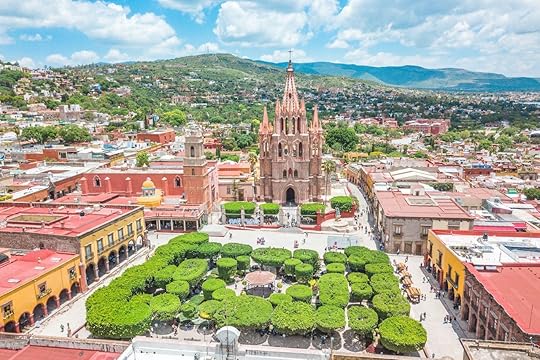
Photo: Rubi Rodriguez Martinez/Shutterstock
Begin the day at La Colmena Panaderia, a grab-and-go Mexican bakery near the center of San Miguel de Allende near the corner of Relox and Mesones streets. Head down Relox Street in the direction of La Parroquia de San Miguel Arcángel to enjoy the view of this very unusual church. The traditional colonial-style appearance of La Parroquia de San Miguel Arcángel was transformed into the pink neo-Gothic one we celebrate today by Zeferino Gutiérrez, an enthusiastic bricklayer and self-taught architect influenced by pictures of European cathedrals, in 1880. Admission is free, and you can visit the crypt below the altar if you ask nicely and are ready to pay a small fee.
Once out of La Parroquia, don’t blow by La Santa Escuela de Cristo, a smaller pink and ochre church located next door. Take in the bell tower from outside and walk in to admire the decor. Both churches are located on San Miguel de Allende’s main square, El Jardín. Full of beautiful topiary trees, El Jardín is a great spot for people watching in the shade.
Mid-morning stroll and visit to a colonial mansion
Photo: Hotel Carmina/Facebook and Hotel Carmina/Facebook
From El Jardín, walk down Cuna de Allende and past the Museo Histórico Casa de Allende (the former house of Mexican Independence leader Ignacio Allende), where you can get a solid history lesson on the town for the low admission fee of $3. Whether you visit the museum or not, make sure to stop at Maria Xoconostle for a mid-morning coffee break and an eyeful of architectural beauty. The restaurant is part of an original 18th-century colonial home, the Posada Carmina. The rest of the structure is a family-run boutique lodging called Hotel Carmina. Take in the original architectural details of the warm, orange-colored home from the inner sanctuary of a courtyard to the high arches while enjoying your beverage.

Photo: Bill Perry/Shutterstock
Coming out of Maria Xoconostle, take a right out and head farther down Cuna de Allende to the corner of Aldama Street. This colorful thoroughfare filled with colonial homes is a great spot for an Insta session as it offers views of the steeple of La Parroquia de San Miguel Arcángel and the dome of the church of the Immaculate Conception (known as Las Monjas, or “the nuns”). Wandering the cobblestone streets from here is a great way to get an intimate look at San Miguel de Allende’s pretty nooks and crannies.
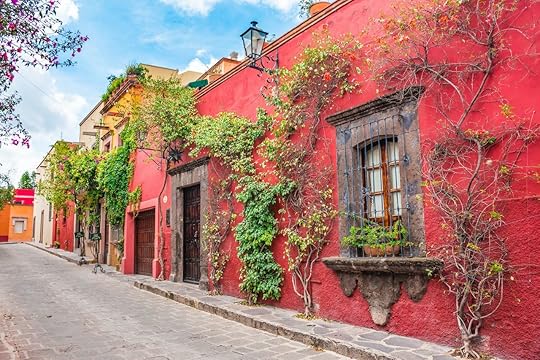
Photo: Rubi Rodriguez Martinez/Shutterstock
Most of the houses on the streets of the historic center of San Miguel de Allende are painted in warm tones like sunny yellow, burnt orange, deep reds, and violets, and many are covered in thick layers of bright pink bougainvillea and other vines. Enjoy the town’s vibrancy during your stroll and pay attention to the small details, like the black iron gates that guard windows and doors and the lintels. Some reflect the simple lines of modern times while others embrace a more ornate design. Look up and admire the traditional folk art of Papel picado, which are the colorful and patterned tissue paper flags. They zigzag from one side of the street to the next in a joyful display.
Late lunch with an iconic view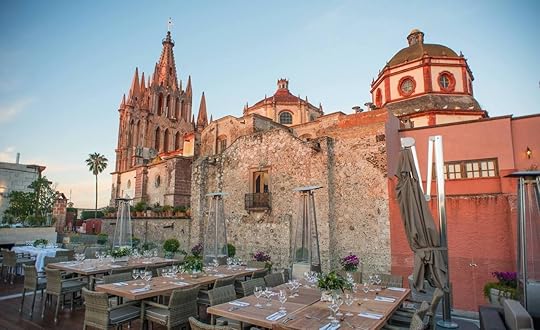
Photo: Quince Rooftop/Facebook
Walking back toward the main square, head to Quince, a stunning rooftop spot for modern eats and refreshing cocktails with breathtaking views of La Parroquia de San Miguel Arcángel’s spires.
End the day with a view from higher ground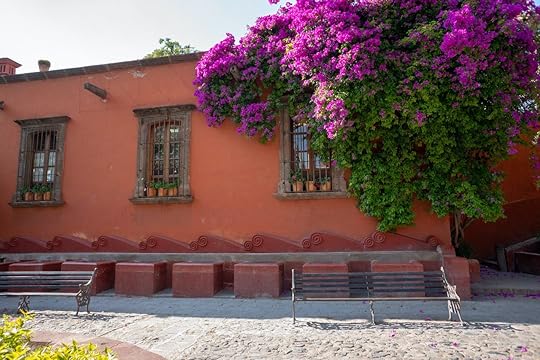
Photo: Omaly Darcia/Shutterstock
Leaving Quince, head right down Cuna de Allende, take a left onto Cuadrante Street, and finally a right onto Aldama Street. A 10-minute walk will bring you to the beautiful and peaceful Benito Juarez Park in the southern part of the city. There, check out the 18th-century red public basins known as Lavaderos del Chorro, a historical landmark, where residents have been hand-washing their laundry for decades.
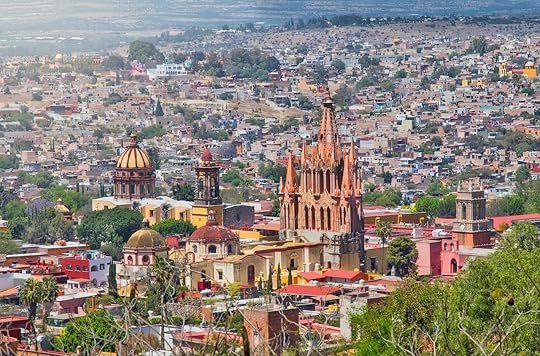
Photo: MARI TERE/Shutterstock
From Lavaderos del Chorro, head east through the adjacent El Chorro park and follow Callejón Chorro before turning left on Salida Real a Querétaro. The nine-minute walk is a little steep and is worth it for one main reason: You’re going to a view point. From El Mirador, you’ll have a picture-perfect view of the town unfolding below.
La Parroquia de San Miguel Arcángel can be seen from almost any angle, as can most of the historic center. This hilltop view is the perfect ending to a day spent walking the charming town of San Miguel de Allende. 
The post The perfect walking tour of Mexico’s most beautiful city: San Miguel de Allende appeared first on Matador Network.
Where to find your favorite celebrity cannabis brands

Cannabis has long been a source of inspiration for musicians, actors, and other performers. So it only makes sense that, as recreational cannabis is legalized in an increasing number of states, celebrities would start their own marijuana brands.
This is great for fans who want to experience the same high that their favorite celebrity approves. What’s less great is how complicated it can be to find specific brands, even if you’re in a legal state. Due to weed still being a Schedule I drug on the federal level, cannabis companies can’t cross state lines. That means any cannabis for sale must be produced in the state it’s sold, and many brands stick to just one or a few states.
Many celebrity brands are worth seeking out when you’re in a state where it is, though. Some align with what you’d guess the celebrity’s cannabis preference is, like Lil Wayne’s GKUA, which focuses on high-THC products. Others have a tight focus on custom strains, like itsPurpl from Jaleel White (who played Steve Urkle in Family Matters), which sells variations on the strain Purple Urkle.
Increasingly, celebrity brands are also focusing on equity. White, for example, wrote on the itsPurpl website that it was challenging to make his “way into an industry not known for diversity or inclusion,” and that the brand is “committed to debunking all stereotypes associated with modern cannabis.” Method Man, who recently expanded distribution of his TICAL cannabis brand to Colorado, puts inclusivity front and center in everything from production to sales.
“I’m particularly excited about TICAL’s focus and leadership in the cannabis space in working with Black, women and minority-owned partners from cultivation to dispensaries,” Method Man told Denver’s Westword. “We are going to lead by example and ensure that this newly created market is as inclusive as possible. We can’t right all the wrongs that disparate criminalization of cannabis has done to our communities, but we most certainly can make a down payment on the way forward with social equity, inclusion and full economic participation.”
Method Man, Lil Wayne, and White are far from the only celebrities with brands to seek out the next time you’re at your favorite dispensary. You can find specific sellers through location searches on WeedMaps, but it all starts with knowing which state these stars sell in.
Where to find celebrity cannabis brandsDr. Greenthumb from B-Real (of Cypress Hill): California
Mirayo from Carlos Santana: California
Trees by Game from The Game: California
GKUA from Lil Wayne: California, Colorado, Michigan, Oklahoma
itsPurpl from Jaleel White: California
Monogram from Jay Z: California
Marley Natural from the Marley family: California
TICAL from Method Man: California, Colorado
Mind Your Head from Mickey Hart (of Grateful Dead): California
Houseplant from Seth Rogan: California
22Red from Shavo Odadjian (of System of a Down): Arizona, California, Nevada
Tommy Chong’s Cannabis: Alaska, Arizona, California, Colorado, Massachusetts, Michigan, Nevada, Oregon, Washington
Willie’s Reserve from Willie Nelson: California, Colorado, Washington, Ohio, Oregon, Nevada 
The post Where to find your favorite celebrity cannabis brands appeared first on Matador Network.
The 10 best US airports for cheap international flights
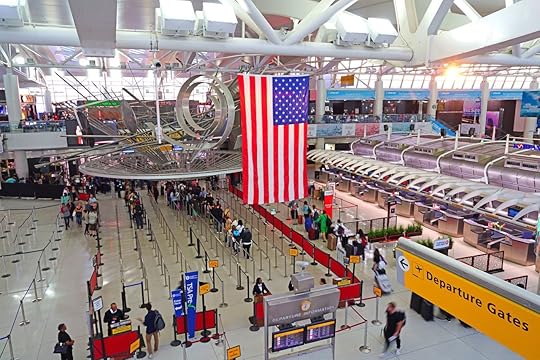
Scoring deals on flights is every traveler’s goal, especially when traveling internationally. To help save your hard-earned dollars, Scott’s Cheap Flights — a website that finds the best flight deals and shares them with its members — created an in-depth report on which airports are the best and worst when it comes to cheap international flights.
Scott’s Cheap Flights looked at commercial international airports in metropolitan areas with at least 1 million inhabitants to determine which ones are scoring the best deals the most frequently. It gathered data on how many deals were sent out to Scott’s Cheap Flights members for flights departing from each airport in the past year.
The report explains why these particular airports provide cheaper international flights: “Some airports simply see more frequent flight deals than others, thanks to a number of factors including the amount of airlines serving the airport and the amount of competition on various routes from that airport.” 
The best US airports for cheap international flights

Data: Scott’s Cheap Flights
Airports in smaller metropolitan areas with fewer flights present fewer deals. Most of the following airports require connection flights — they don’t offer direct international flights — which leads to “a lack of competition and the lack of deals,” the report explains.
The worst US airports for cheap international flights
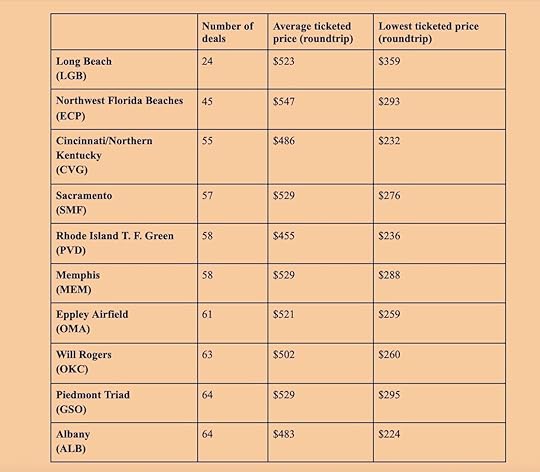
Data: Scott’s Cheap Flights
More like thisNewsThe 10 most expensive airport parking lots in the USThe post The 10 best US airports for cheap international flights appeared first on Matador Network.
The Million Dollar Highway is Colorado’s ultimate road trip through the Old West
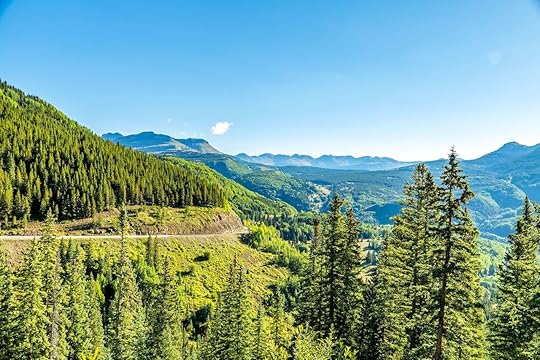
The stretch of US Highway 550 between Ouray and Silverton in Southwest Colorado is dubbed the Million Dollar Highway. There’s no definitive answer as to why. One legend says there’s a million dollars worth of gold ore in the road fill. According to another, early travelers refused to go back over the treacherous mountain road, “not even for a million dollars.” Though the name could simply reflect the highway’s million-dollar views in the San Juan Mountains.
One thing is clear, however — with less than 25 miles of pavement, the highway packs a lot of bang for its buck. Otto Mears, known as the “Pathfinder of the San Juans,” originally built it as a toll road in 1883 and though it’s now paved and passable, its winding path over Red Mountain Pass remains one of Colorado’s most stunning — if, at times, intimidating — drives. Here’s what to do and where to stop along the way.
Spend a day or two in the “Switzerland of America”
Photo: Susan Hoffman/Shutterstock
Ouray marks the north end of the Million Dollar Highway. Incorporated in 1976, it was named after Ute Chief Ouray. Since the late 1800s, it’s had the nickname “Switzerland of America” because of its resemblance to mountain towns in the Alps. Start here with an early morning hike on Perimeter Trail, an ultra-popular six-mile loop filled views and waterfalls. With multiple trailheads like Baby Bathtubs or Lower Cascade Falls, you can easily shorten the hike to make it more accessible and faster. Afterward, stop at Mojo’s. Housed in a cute Victorian-style home, the coffeehouse has great lattes and breakfast burritos and is the perfect place to relax and scroll your photos of the hike.
Box Cañon Falls is a primary draw to Ouray, located just outside of town. Head here in the morning to beat the crowds. You’ll hear the thunderous roar of the falls well before descending the caged metal staircase to the base of the 285-foot waterfall plummeting down the narrow quartzite canyon. The Black Swift is notoriously a difficult bird to spot, but you’re almost guaranteed to see one in the narrow canyon in summer since the canyon here is home to one of Colorado’s largest Black Swift colonies. Snap some shots of the falls, enjoy the cool mountain air, and then take the Native Plant Loop trail back to the parking lot for a panoramic view out across the valley.
I spent the afternoon downtown at the Ouray County Museum, housed in the St. Joseph’s Miners’ Hospital. Completed in 1887, the Catholic organization Sisters of Mercy from Denver, Durango and Omaha operated the hospital until 1964. The three-story museum houses more than 40 exhibits in 30 rooms, including several original pioneer cabins, comprising what the Smithsonian Institute calls the “best little museum in the West.” The experience takes up to two hours and includes the history of mining, ranching, railroading, and hospital artifacts from life in Ouray in the late 1800s through the early 1900s.
From the museum, go on a leisurely stroll on Ouray County Historical Society’s self-guided walking tour. It’s a great way to see some of the Victorian era homes and Ouray’s historic buildings. Signs on Main Street’s historic blocks show what each looked like circa 1883 and 1903, when the town was rich with miners, gold diggers, and others trying to, well, make it rich. Cool off with a huckleberry ice cream cone at Mouse’s Chocolates and Coffee.
You can’t spend time in Ouray without soaking in the Ouray Hot Springs. A draw for weary travelers for centuries, the 150-degree mineral water comes from the box canyon you visited earlier and flows into soaking pools ranging in temperature from 75 to 104 degrees.
There are several historic hotels for an overnight in Ouray, but my favorite is the budget-friendly and family-owned Ouray Chalet Inn for its 1960s roadside motel feel. Before retreating to your room for the night, nosh on a burger or pizza on the expansive patio at Gold Belt Bar and Grill.
Take the Iron Path to the best views of Uncompaghre GorgeView this post on InstagramA post shared by Ouray Via Ferrata (@ourayviaferrata)
If heights don’t intimate you, then tackle the Ouray Via Ferrata, a fixed-line climbing route built by local climbing and guiding professionals. The term “Via Ferrata” is Italian for “iron path” or “iron road.” These routes originated in the Dolomites during World War I to get men and equipment into strategic positions in high-alpine, rugged mountain terrain. Here in Ouray, you can go on a guided tour or experienced climbers can tackle the route self-guided. Ascending the “Sky Ladder” at a 35-degree angle for 75 feet above the Uncompaghre Gorge is an experience you won’t soon forget. The Ouray Via Ferrata is approximately 1.25 kilometers (.77 miles) long and takes between two and three hours. Since I’m a meteorologist, my pro tip is to do this adventure early to beat the heat and summertime storms which can start as early as 10 a.m. in the high country.
Drive the beautiful (but scary) Red Mountain Pass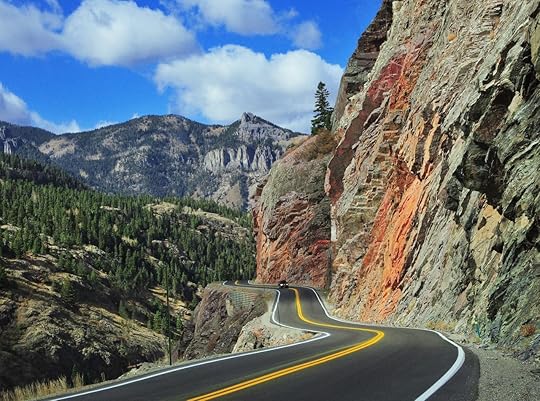
Photo: Jay Krishnan/Shutterstock
The highlight of the Million Dollar Highway is the highway itself. Allow at least one or two hours to drive the 25-mile stretch as its filled with steep grades, hairpin curves, and a precariously obvious lack of guard rails. There are also many sightseeing stops to make along the way, with pull-outs. Your first stop should be Lookout Point just above Ouray to take in a stellar view of the town. From there, the first six miles are dramatic as you drive deeper into the Uncompaghre Gorge.
Pull off for roadside views of Bear Creek Falls, the first waterfall you’ll see en route. As the road mellows (relatively speaking, at least), be on the lookout for mining relics including Ironton and Red Mountain Town, two former mining camps just off the highway. Continue heading south to my favorite spot of the mining overlook, Treasure Tunnel trestle, with outstanding views of mining relics dotting Red Mountain. Plus, there are a few historic homes in Red Mountain Town, once the largest mining camp in the area with close to 10,000 residents.
Keep an eye out for more waterfalls on both sides of the Million Dollar Highway as you drive up Red Mountain Pass to a summit elevation of 11,018 feet. Gold ore wagons first crossed over the pass in 1878. From the summit, continue the scenic drive into Silverton. You’ll see mining relics sprinkled on the mountains and roadside.
Explore Silverton’s rich past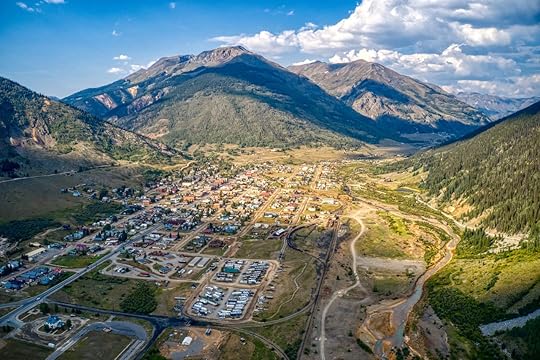
Photo: Jacob Boomsma/Shutterstock
Dubbed the “mining town that never quit,” Silverton’s mining history spans from the mid-1800s to 1991. The Victorian mining town has a rich and rough history. Over two million troy ounces of gold, 51 million ounces of silver, 112 million pounds of copper, 760 million pounds of lead, and 600 pounds of zinc were mined primarily from mines at 12,000 feet in elevation or higher, a dangerous occupation that has made Silverton’s residents even today among the hardiest in the state.
Grab a latte and square burrito at Coffee Bear and enjoy the view from Silverton’s only rooftop deck. Sitting at 9,318 feet in elevation, you’ll need a jacket most mornings even in summer. Take a short drive south to the picturesque Little Molas Lake. From the campground, you can access part of the Colorado Trail and do an out-and-back hike in one of the most scenic stretches of the iconic long-distance hiking trail stretching from Denver to Durango. Storms often brew in the afternoon here so a good plan of action is to head up mid-morning and keep your hike to around three miles round trip, then grab a quick lunch at Coal Bank Café. Spend an hour or so in the afternoon at San Juan County Historical Mining Heritage Center beginning with a self-guided tour of the 1902 Silverton County Jail Museum. From there, head into the basement to wander through exhibits on Silverton’s mining history, including three levels of a former mine that make up the four-story museum.
You can also take the Old Hundred Gold Mine Tour to gather more on the town’s history. In 1872, the first of three Neigold brothers arrived from Germany to stake their claim on the “Number Seven” vein here and the three brothers would spend the next 30 years prospecting and developing mining veins in the area. One of those claims in 1898 was named “Old Hundred,” likely after the popular German hymn “Old Hundreth.” Here you ride a vintage electric train 1500 feet deep into Galena Mountain where you walk through the quartz vein tunnels, called drifts by the miners.
On my way back into Silverton, stop at the 1929 Mayflower Gold Mill. You don’t need reservations to visit the national historic landmark. As underground lode mining became the most profitable way to mine in the area, the Mayflower Gold Mill starting processing ore in 1930 and ran until 1991. Visit the Aerial Tram House and check out the remains of the 10,000-foot-long tram that carried miners on a 22.5-minute ride to the mines on the other side.
Keeping with the Old West theme, saunter into Handlebars Food and Saloon for Silverton’s classic chuckwagon supper. Spend the night at the Wyman Hotel, seamlessly blending historic and modern with a touch of funky in a building built in 1902.
Rent a four-wheeler and visit the historic settlement of Animas Forks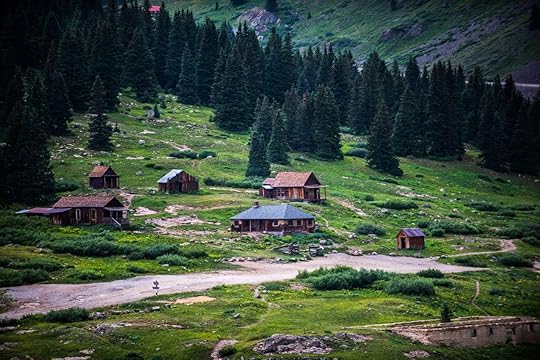
Photo: Kris Wiktor/Shutterstock
Your second day in Silverton should be spent getting above the town. Rock Pirates rents a quirky but contraption called a side-by-side, which is a hybrid four-wheeler and Jeepish contraption that can barrel up nearly anything in the high country. Rent one and follow an OHV (off-highway vehicle) route up an unimproved dirt road to Animas Forks at an elevation of 11,200 feet. Animas Forks was a small mining village that at its peak in 1883 had 450 people with 30 cabins and a hotel, general store, and saloon. It was also home to the Animas Forks Pioneer, the only newspaper ever published and printed at such a high elevation. A 23-day blizzard inundated the town with 25 feet of snow in 1884, a hit to the mining profits that eventually led to the decline of Animas Forks. By the 1920s, the town was a ghost town. You can tour some of the cabins and the jail here before heading back to town. 
The post The Million Dollar Highway is Colorado’s ultimate road trip through the Old West appeared first on Matador Network.
Most beautiful US college campuses

You don’t choose a college based on its looks, but if the place where you’re planning on spending most of your time for the next four (or more) years is stunning, it can only be a good thing. After all, your campus is your home away from home, so choosing one that’s gorgeous, as well as well-rated, is a surefire way for you to have the time of your life. From amazing natural surroundings to breathtaking architectural pieces, here are 13 beautiful college campuses in the United States that are sure to be a source of pride for the students and the staff.
University of Virginia — Charlottesville, VA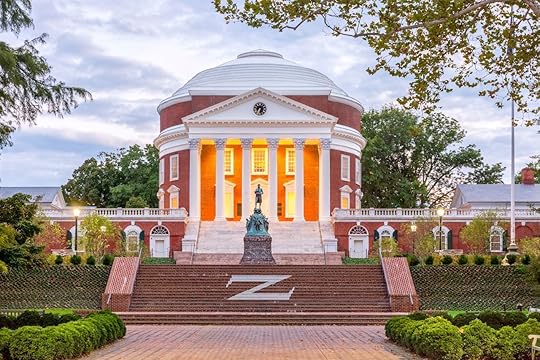
Photo: BrianPIrwin/Shutterstock
The only university in the US designated a UNESCO World Heritage site, the University of Virginia is one of the oldest in the country, founded in 1819 by Thomas Jefferson. The author of the Declaration of Independence and the third US president was a talented architect, and the Academical Village he designed is still at the heart of the campus.
Dominated by the Rotunda inspired by the Pantheon in Rome, the Academical Village follows a U-shaped plan, where the buildings surround the Lawn, a terraced green space. The Rotunda, the school’s iconic, most recognizable building, stands on the northern side of the Lawn. Ten pavilions interspersed with student rooms extend on its sides, each built in a different style, with their own gardens, separated by serpentine walls.
St. Olaf College — Northfield, MN
Photo: Ken Wolter/Shutterstock
St. Olaf’s picturesque campus, known as “the Hill,” is set amid restored wetlands, woods, and native tall-grass prairies. Opened by Norwegian-Americans in the late 19th century, the College prides itself in environmental sustainability, being the first in the nation to use a wind turbine to supply about one-third of the school’s energy.
The college’s most recognizable landmark is the beautiful Gothic-style Old Main, built in 1877, the first structure on the grounds. One of the more modern buildings, the Christiansen Hall of Music, was recognized by the American Institute of Architects in its Architecture MN magazine.
University of Washington — Seattle, WA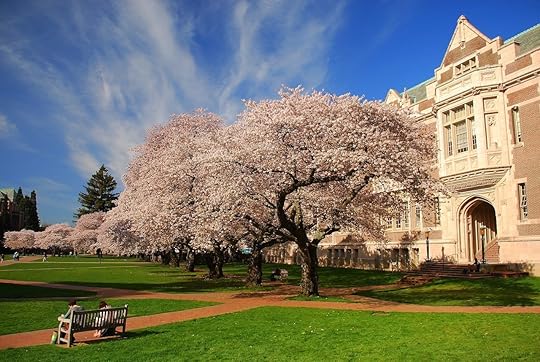
Photo: Mike Peters/Shutterstock
The University of Washington’s main campus has gorgeous views in all directions, including some of Mount Rainier, the Cascades Range, and the Olympic Mountains. Red Square is at the heart of this campus, surrounded by landmark buildings, like the Suzzallo library with its 35-foot-high stained-glass windows and gilded vaulted ceiling.
But it’s the North Campus that has UWA’s most recognizable landmark, the Liberal Arts Quad. Filled with cherry blossoms, courtesy of the 31 Yoshino cherry trees, the grounds of the Quad put up quite a show each spring.
Florida Southern College — Lakeland, FL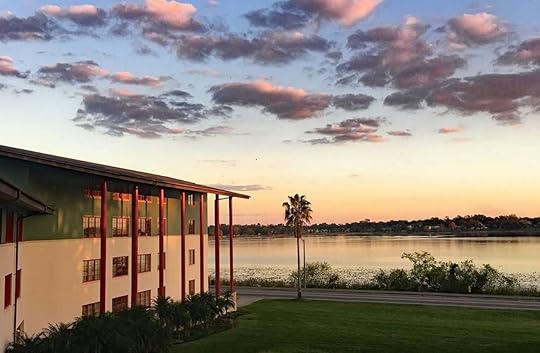
Photo: Florida Southern College
Sitting on a hillside overlooking Lake Hollingsworth, Florida Southern College is home to the world’s largest number of Frank Lloyd Wright buildings. A National Historic Landmark since 2012, the campus was dubbed the “first uniquely American campus” and is listed on the National Register of Historic Places.
One particularity of the Florida Southern College campus is the many cats you’ll encounter while gawking at the gorgeous architecture and natural surroundings. Around 30 cats live around the campus. They’re all neutered/spayed and vaccinated. A small team of caretakers feed and care for them every day.
University of Chicago — Chicago, IL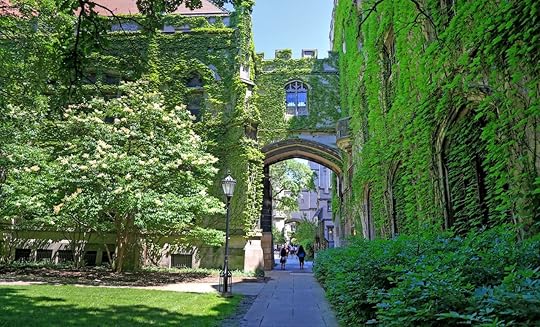
Photo: STLJB/Shutterstock
The campus of the University of Chicago combines traditional English Gothic-style architecture with modern design in a setting that seems like a small pocket of nature in the middle of Chicago. The 217-acre campus includes a few parks and an official botanical garden. The surroundings include a pond — home to ducks, turtles, and dragonflies.
The gorgeous Cobb Lecture Hall, built in 1892, was the first of the university’s original 16 buildings. The nearby ivy-filled Hitchcock Hall, built in 1900, has been on the list of the National Register of Historic Places since 1974.
The campus is also home to the Robie House, a Frank Lloyd Wright building and a National Historic Landmark.
Berry College — Rome, GA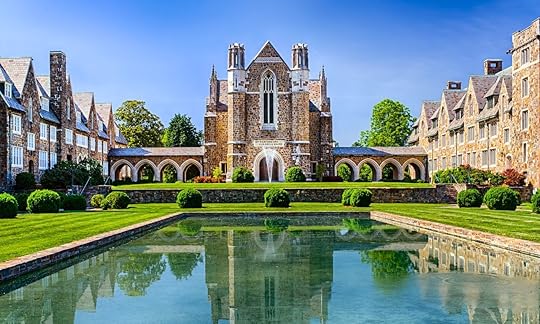
Photo: Rob Hainer/Shutterstock
Berry College’s campus is the largest in the contiguous US and its 27,000 acres include forests, fields, and Lavender Mountain. With over 80 miles of trails, surrounded by wooded areas, streams, and ponds, it is a great place to spend time outside the classrooms.
The area around the academic English-Gothic style buildings, surrounded by fountains and pools, is a wildlife refuge. Mary Hall and the Ford Dining Hall are the most recognizable buildings on campus. The oldest buildings, rustic and representative of the College’s history, are the Roosevelt Cabin, House o’Dreams, and Old Mill.
Princeton University — Princeton, NJ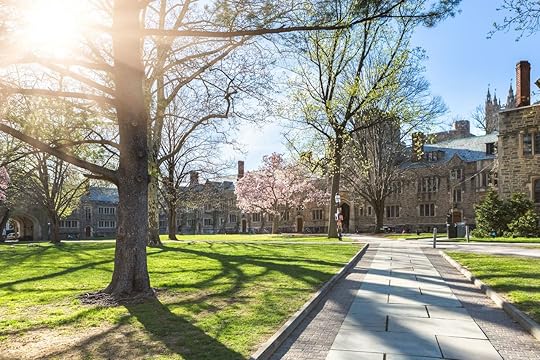
Photo: ssguy/Shutterstock
Princeton is filled with beautiful buildings surrounded by perfectly manicured green expanses, courtyards, and hundreds of crisscrossing paths. It’s like an American version of Hogwarts, but without the Quidditch pitch.
Completed in 1756, the stunning Nassau Hall is the oldest building on campus. Before becoming the center of the campus, it was the original home of the New Jersey Legislature and the Seat of the Congress of the Confederation. Involved in the battle of 1777, it was added to the National Register of Historic Places in 1966.
Pepperdine University — Malibu, CA
Photo: Pepperdine University/Facebook
Sitting among several ridges overlooking the Pacific, in the foothills of Santa Monica mountains, the campus of Pepperdine University is one of the most scenic in the country. Palm trees dot the landscape and give the campus a tropical feel, accented by the Mediterranean-style buildings with white stucco and red roofs.
Alumni Park offers trails among hills, ponds, coral trees, and lawns with views of the ocean.
Lewis and Clark College — Portland, OR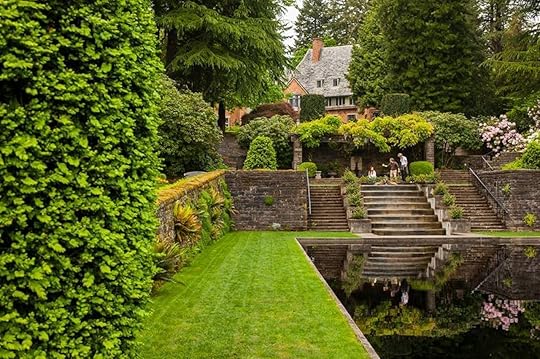
Photo: Lewis & Clark College
Set on top of Palatine Hill, the forested 137-acre campus of Lewis and Clark College bathes in nature. Surrounded by woods, its centerpiece is the historic Frank Manor House, a rustic, Tudor-style mansion, designed by local architect Herman Brookman and built in 1924.
A large pool bordered by flower beds sits at the back entrance of the mansion and the Tree Walk that consists of native tree species encountered by Lewis and Clark on their journey surrounds it.
The views of the perpetually snow-capped Mount Hood, about 50 miles away, add a touch of magic to the already incredible natural beauty of the campus.
Bryn Mawr College — Bryn Mawr, PA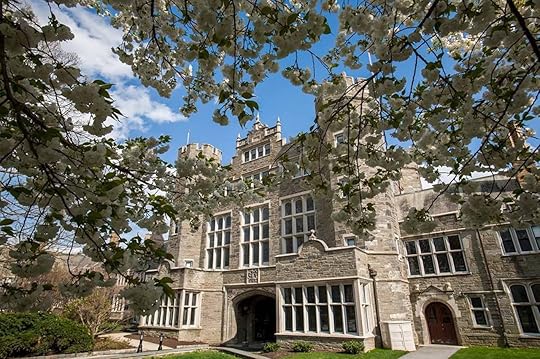
Photo: Bryn Mawr College
The campus of Bryn Mawr College has the perfect balance of lush green surroundings and gorgeous buildings. The whole 135-acre campus is designed as an arboretum, with more than 75 varieties of trees and scenic trails, as well as a duck pond.
The stone buildings themselves are the highlight of this college, however. When walking into one of them, you’ll feel like you’re stepping into an ancient castle. As the oldest examples of this style of architecture in the US, known as Collegiate Gothic, they’ve been a model for other colleges since 1885.
University of Colorado — Boulder, CO
Photo: University of Colorado Boulder
You can’t beat the setting of the University of Colorado, with gorgeous views of the Rocky Mountains and Flatirons, including a lake and two creeks. The buildings match the setting, featuring a distinctive architectural style, with local sandstone walls, limestone trim, and red-tiled roofs.
Built in 1876, the Old Main was the first building on campus, and it’s now home to a museum of the college’s history and the Heritage Center.
Vassar College — Poughkeepsie, NY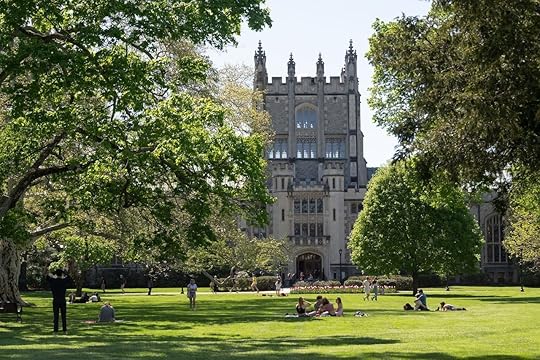
Photo: Vassar College/Facebook
Founded originally as a women’s college in 1861, Vassar College’s campus is an official arboretum that’s comprised of over 230 species of trees. Trees are an integral part of Vassar’s green space, as founder Matthew Vassar personally oversaw the initial tree plantings, and class tree planting has been a tradition ever since the class of 1868 decided to plant a swamp white oak along Main Drive.
The buildings across the 1,000-acre campus aren’t limited to a single architectural style, ranging from Collegiate-Gothic to Norman. One of its most notable buildings is the Thompson Memorial Library, reminiscent of a mythical castle.
Furman University — Greenville, SC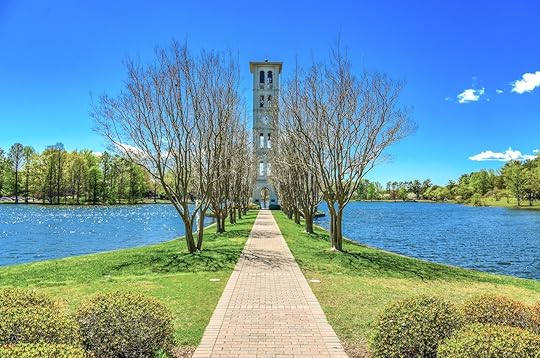
Photo: Kevin Ruck/Shutterstock
Furman University’s 750-acre campus is lakeside, which gives it a very serene vibe. Most of the buildings are in the Georgian architecture style, but it’s the Florentine bell tower by the lake that’s one of the real draws.
Another eye-catching feature is Furman’s Asia Garden. It originally contained just native Japanese flora like bamboo and maples but was refurbished in 2007 and expanded to include other plants. The garden sits by a pond and has a small waterfall. Near the garden is the Place of Peace, which has the first Japanese temple to ever to be disassembled, shipped, and reconstructed in the US. The multigenerational temple was built in 1984 in Nagoya and was donated in 2004 by the Tsuzuki family.
Stanford University — Palo Alto, CA
Photo: Diego Grandi/Shutterstock
Schools located in California seem to have a leg up in the “most beautiful campus” competition. After all, palm trees can give any campus a welcome dose of character. In addition to being one of the best schools in the country, Stanford is also known for its stunning campus aesthetic. The aptly-named Palm Drive leading up to the Main Quad is a pretty good hint of what’s to come on a visit to Stanford. The quad is surrounded by Romanesque buildings featuring distinctive red-tile roofs and a buff sandstone aesthetic. The Memorial Church is probably Stanford’s most recognizable structure, largely thanks to its colorful mosaic facade and equally striking interior. A casual stroll is a great way to take in the campus’ beauty, but for a more panoramic, all-encompassing view, head to the top of the Hoover Tower. If the weather cooperates, you can even see all the way to San Francisco.
Rice University — Houston, TX
Photo: Rice University/Facebook
Houston isn’t exactly known for its architecture, which is what makes Rice University even more interesting. Though located in the heart of a dense urban area, Rice’s campus manages to impart a sense of tranquility. Located on a heavily wooded plot of land, the campus is enclosed by a double row of oak trees, and throughout the campus you’ll also find thousands of maples, hickories, and elms. The buildings were built in the Mediterranean Revivalist style, with light brick facades, archways, and decorative columns, creating the fleeting illusion that you’re in Spain rather than Houston, Texas.
College of William & Mary — Williamsburg, VA
Photo: William Silver/Shutterstock
If you’ve ever been to Colonial Williamsburg, you probably passed right by the College of William & Mary. Unlike much of Colonial Williamsburg, the college is a fully functioning, modern education institution. The word “modern,” however, only applies to the school’s education. The school is the second-oldest in the country, just behind Harvard, founded in 1693. Many of its colonial-era buildings still remain, including the stately Wren Building — the oldest college building still standing in the US. The colonial-style Brafferton (built in 1723) and the President’s House (built in 1732) combine with the Wren to form “Ancient Campus.” Apart from the beautiful architecture, there’s also the Sunken Garden, the sprawling green lawn from the Wren Building to Crim Dell Pond where students often congregate.
Cornell University — Ithaca, NY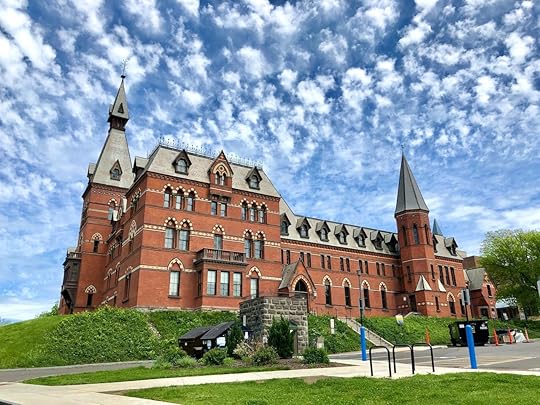
Photo: PQK/Shutterstock
Cornell’s campus stands apart from other Ivy League universities for its location overlooking the city of Ithaca and Cayuga Lake. It sits right on Fall Creek Gorge and Cascadilla Gorge, which has eight waterfalls cascading over 400 feet from the campus to downtown Ithaca. The campus also offers views of the surrounding valleys of the Finger Lakes region, one of the most beautiful areas in upstate New York. Also on campus are the Cornell Botanic Gardens, a 2,800-acre garden with flowers, trees, ponds, and trails for students and visitors. 
A version of this article was previously published on August 3, 2018, and was updated on August 12, 2021.
More like thisArt + ArchitectureThe 8 most magnificent university libraries to get lost inThe post The 17 most beautiful college campuses in the US appeared first on Matador Network.
Matador Network's Blog
- Matador Network's profile
- 6 followers



